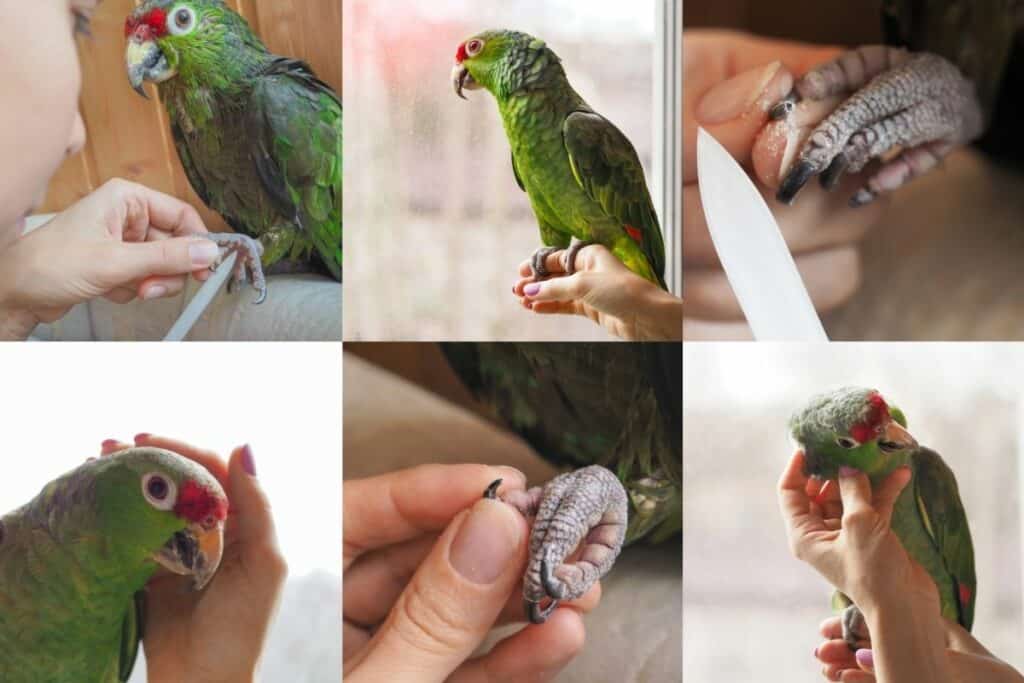If you are wondering how long a parrot’s claws should be, you may be seeking to evade an important task that many parrot owners dread. Trimming your parrot’s nails is not for the fainthearted but it is necessary for a parrot’s health.
In their natural habitats, the active lifestyle of wild parrots including foraging, climbing trees, and perching on a variety of branches is effective at keeping claw length in check.
But captive birds often do not have the opportunity to exercise the natural behaviors that would keep their fast-growing claws in check. This means the nails of pet parrots will need to be trimmed.
Knowing the right length to aim for will keep your pet’s nails at their best and give you confidence in taking care of your parrot’s feet. Read on for everything you need to know about parrot claw length and how to trim them safely.
Table of Contents
How parrots use their claws
Your parrot uses its claws as hands, feet, and everything in between. Each claw is essentially a long, curved toenail that emerges from a nailbed at the tip of each of their four toes, making eight claws in total.
Your parrot will rely on them for perching, walking, and handling objects like food. Of course, the claws are sharp and your parrot is more than prepared to use them in self-defense, which may make you apprehensive about trimming them.

So, how long should a parrot’s claws be?
The ideal length of a parrot’s claw will vary from bird to bird. With hundreds of parrot species, it is impossible to settle on a specific length.
Parrot claw length should be determined by your parrot’s level of comfort and ability to use them in their normal activities. A normal claw length won’t wrap all the way around the parrot’s perch and will not grow out to one side or other. When moving, perching, gripping objects becomes difficult it is time to give your parrot’s claws a trim.
Key signs that your parrot’s claws are ready for a trim.
It is wise to familiarise yourself with the signs that your parrot’s nails need to be trimmed before they become excessively long.
If this is done regularly a parrot’s claws are usually trimmed every two months or longer depending on the rate of nail growth. Here are some signs that your parrot is ready for its next manicure.
- Your parrot is uncomfortable perching – changes in perching behavior like a preference for one foot or frankly standing on the floor are clear signs that the nails are overgrown and need to be tackled urgently.
- The nails look overgrown – if they look overgrown, they probably are, especially if they are curling right around the perch.
- You are getting scratched when you hold your parrot – though you will feel your parrot’s claws when you hold them, if they are excessively sharp or dig in, they are likely too long.
- Dropping toys – long nails will get in the way of grasping and grappling their favorite toys.
- Claws get stuck in toys or clothing – again the claws will start to get in the way of the normal movement and activity of the parrot
- The skin of the feet is dry and scaly – overgrown claws are flaky and scaly. Your bird’s skin may also have sore spots where normal scratching and grooming has broken the skin because of the length and sharpness of the nails.
Can I trim my parrot’s claws?
Of course your can. Owners regularly trim their parrot’s claws at home, but if you are not confident to do this task yourself you can always take your parrot to the vet.
To trim parrot nails yourself requires good bonding and trust from your parrot. An advantage of using the vet is that they have the personnel to safely restrain your parrot and cut down his claws quickly.

How to trim parrot claws.
To complete all stages of trimming your parrot’s nails safely you will need an extra person, especially if you are doing this for the first time.
- To keep your parrot safe and calm during the clipping process, it will need to be wrapped in a towel. Acclimatize your pet to the towel before you wrap the towel around its shoulders, restraining its wings but keeping its head clear but supported so it cannot bite.
- Each nail should be examined. This is done by offering your finger for your pet to grasp and lifting each nail with your thumb.
- You must identify the blood vessels that run into the parrot’s nails so that they are not accidentally cut as you trim. This part is known as the quick and may be difficult to identify in darker-colored nails.
- The nails can be effectively cut with small or large clippers, guillotine clippers, or even an electric file. Cut small portions of the nail as you go, taking care not to cut the quick.
- Remember to trim rather than cut off large amounts of the claw. If you accidentally cut through the quick, you can get some pretty heavy bleeding.
- Parrot owners can obtain a blood-stopping power called styptic powder that can stop any bleeding long enough for you to take the parrot to the vet.
Rounding up
Taking care of your parrot’s claws is a routine part of pet care. Throughout the process, encourage and praise your bird so that they remain calm and cooperate with having their nails trimmed.
Once you finish, offer your parrot a generous treat to keep them positive for the next time!




